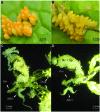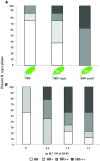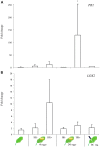Role of Large Cabbage White butterfly male-derived compounds in elicitation of direct and indirect egg-killing defenses in the black mustard
- PMID: 26483811
- PMCID: PMC4586945
- DOI: 10.3389/fpls.2015.00794
Role of Large Cabbage White butterfly male-derived compounds in elicitation of direct and indirect egg-killing defenses in the black mustard
Abstract
To successfully exert defenses against herbivores and pathogens plants need to recognize reliable cues produced by their attackers. Up to now, few elicitors associated with herbivorous insects have been identified. We have previously shown that accessory reproductive gland secretions associated with eggs of Cabbage White butterflies (Pieris spp.) induce chemical changes in Brussels sprouts plants recruiting egg-killing parasitoids. Only secretions of mated female butterflies contain minute amounts of male-derived anti-aphrodisiac compounds that elicit this indirect plant defense. Here, we used the black mustard (Brassica nigra) to investigate how eggs of the Large Cabbage White butterfly (Pieris brassicae) induce, either an egg-killing direct [i.e., hypersensitive response (HR)-like necrosis] or indirect defense (i.e., oviposition-induced plant volatiles attracting Trichogramma egg parasitoids). Plants induced by P. brassicae egg-associated secretions expressed both traits and previous mating enhanced elicitation. Treatment with the anti-aphrodisiac compound of P. brassicae, benzyl cyanide (BC), induced stronger HR when compared to controls. Expression of the salicylic (SA) pathway- and HR-marker PATHOGENESIS-RELATED GENE1 was induced only in plants showing an HR-like necrosis. Trichogramma wasps were attracted to volatiles induced by secretion of mated P. brassicae females but application of BC did not elicit the parasitoid-attracting volatiles. We conclude that egg-associated secretions of Pieris butterflies contain specific elicitors of the different plant defense traits against eggs in Brassica plants. While in Brussels sprouts plants anti-aphrodisiac compounds in Pieris egg-associated secretions were clearly shown to elicit indirect defense, the wild relative B. nigra, recognizes different herbivore cues that mediate the defensive responses. These results add another level of specificity to the mechanisms by which plants recognize their attackers.
Keywords: Brassicaceae; PR-1; Pierisaccessory reproductive glands; egg parasitoid; hypersensitive response; induced plant defenses; oviposition-induced plant volatiles.
Figures





Similar articles
-
Chemical, Physiological and Molecular Responses of Host Plants to Lepidopteran Egg-Laying.Front Plant Sci. 2020 Jan 30;10:1768. doi: 10.3389/fpls.2019.01768. eCollection 2019. Front Plant Sci. 2020. PMID: 32082339 Free PMC article. Review.
-
Prospects of herbivore egg-killing plant defenses for sustainable crop protection.Ecol Evol. 2016 Sep 7;6(19):6906-6918. doi: 10.1002/ece3.2365. eCollection 2016 Oct. Ecol Evol. 2016. PMID: 28725368 Free PMC article. Review.
-
Male-derived butterfly anti-aphrodisiac mediates induced indirect plant defense.Proc Natl Acad Sci U S A. 2008 Jul 22;105(29):10033-8. doi: 10.1073/pnas.0707809105. Epub 2008 Jul 14. Proc Natl Acad Sci U S A. 2008. PMID: 18626017 Free PMC article.
-
Attraction of egg-killing parasitoids toward induced plant volatiles in a multi-herbivore context.Oecologia. 2015 Sep;179(1):163-74. doi: 10.1007/s00442-015-3325-3. Epub 2015 May 8. Oecologia. 2015. PMID: 25953114
-
Anti-aphrodisiac compounds of male butterflies increase the risk of egg parasitoid attack by inducing plant synomone production.J Chem Ecol. 2009 Nov;35(11):1373-81. doi: 10.1007/s10886-009-9714-5. Epub 2009 Dec 1. J Chem Ecol. 2009. PMID: 19949841 Free PMC article.
Cited by
-
Chemical, Physiological and Molecular Responses of Host Plants to Lepidopteran Egg-Laying.Front Plant Sci. 2020 Jan 30;10:1768. doi: 10.3389/fpls.2019.01768. eCollection 2019. Front Plant Sci. 2020. PMID: 32082339 Free PMC article. Review.
-
Arabidopsis, tobacco, nightshade and elm take insect eggs as herbivore alarm and show similar transcriptomic alarm responses.Sci Rep. 2020 Oct 1;10(1):16281. doi: 10.1038/s41598-020-72955-y. Sci Rep. 2020. PMID: 33004864 Free PMC article.
-
Prospects of herbivore egg-killing plant defenses for sustainable crop protection.Ecol Evol. 2016 Sep 7;6(19):6906-6918. doi: 10.1002/ece3.2365. eCollection 2016 Oct. Ecol Evol. 2016. PMID: 28725368 Free PMC article. Review.
-
Genetic analysis reveals three novel QTLs underpinning a butterfly egg-induced hypersensitive response-like cell death in Brassica rapa.BMC Plant Biol. 2022 Mar 24;22(1):140. doi: 10.1186/s12870-022-03522-y. BMC Plant Biol. 2022. PMID: 35331150 Free PMC article.
-
Juvenile Spider Mites Induce Salicylate Defenses, but Not Jasmonate Defenses, Unlike Adults.Front Plant Sci. 2020 Jul 10;11:980. doi: 10.3389/fpls.2020.00980. eCollection 2020. Front Plant Sci. 2020. PMID: 32754172 Free PMC article.
References
-
- Aplin R. T., D’Arcy Ward R., Rothschild M. (1975). Examination of the large white and small white butterflies (Pieris spp.) for the presence of mustard oils and mustard oil glycosides. J. Entomol. 50 73–78. 10.1111/j.1365-3032.1975.tb00094.x - DOI
LinkOut - more resources
Full Text Sources
Other Literature Sources
Research Materials
Miscellaneous

